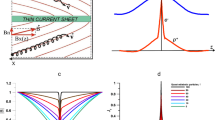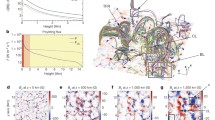Abstract
The quiet-Sun magnetic field emerges through the solar photosphere in a multitude of mixed-polarity magnetic concentrations and is subsequently tangled up into intricate regions of interconnecting flux. Moreover, since these discrete concentrations are likely to be extremely small in size, with fluxes of around only 1017 Mx, the number of such flux sources in, say, a supergranule, will be extremely large. The flux-tube tectonics model of Priest, Heyvaerts, and Title (2002) demonstrated how the formation and dissipation of current sheets along the separatrices that separate the regions of different connectivity are likely to make an important contribution to coronal heating. Since the full complexity of the magnetic field is below present observable scales, this study examines the effect of having the magnetic flux emerge through configurations structured on smaller and smaller scales. It is found that, by fixing the amount of flux emerging into a given 2D region, the main factors influencing the current build-up along the separatrices are the number of sources through which the flux emerges and the spatial distribution of the sources on the photosphere. The free energy (i.e., that above potential) is stored lower and lower in the atmosphere as the complexity of the system increases. A simple comparison is then made between coronal heating by separator currents and by separatrix currents. It is found that both result in comparable amounts of energy release, with separatrix heating being the more dominant.
Similar content being viewed by others
References
Amari, T. and Aly, J. J.: 1990, Astron. Astrophys. 231, 213.
Close, R. M., Parnell, C. E., Longcope, D. W., and Priest, E. R.: 2004, Astrophys. J. 612, L81.
Dungey, J. W.: 1958, Cosmic Electrodynamics Cambridge University Press, Cambridge, UK.
Galsgaard, K. and Nordlund, A.: 1997, J. Geophys. Res. 102, 231.
Galsgaard, K., Parnell, C. E., and Blaizot, J.: 2000, Astron. Astrophys. 362, 395.
Goossens, M.: 1991, Advances in Solar System MHD Cambridge University Press, Cambridge, UK, p. 137.
Hagenaar, H. J.: 2001, Astrophys. J. 555, 448.
Heyvaerts, J. and Priest, E. R.: 1984, Astron. Astrophys. 137, 63.
Hollweg, J. V.: 1983, Solar Wind 5 NASA CP-2280, Washington, DC, p. 1.
Lau, Y. T. and Finn, J. M.: 1990, Astrophys. J. 350, 672.
Lau, Y. T. and Finn, J. M.: 1996, Phys. Plasmas3, 3983.
Livingston, W. C. and Harvey, J. W.: 1975, Bull. Amer. Astron. Soc. 7, 346.
Longcope, D. W.: 1996, Solar Phys. 169, 91.
Longcope, D. W.: 1998, Astrophys. J. 507, 433.
Longcope, D. W.: 2001, Phys. Plasmas8, 5277.
Low, B. C.: 1977, Astrophys. J. 212, 234.
Martin, S. F.: 1988, Solar Phys. 117(2), 243.
Mellor, C., Gerrard, C. L., Galsgaard, K., Hood, A. W., and Priest, E. R.: 2004, Solar Phys, submitted.
Parker, E. N.: 1972, Astrophys. J. 174, 499.
Parker, E. N.: 1979, Cosmical Magnetic Fields Oxford University Press, Oxford.
Parker, E. N.: 1994, Spontaneous Current Sheets in Magnetic Fields Oxford University Press, Oxford.
Parnell, C. E. and Priest, E. R.: 1995, Geophys. Astrophys. Fluid Dynam. 80, 255.
Priest, E. R. and Titov, V. S.: 1996, Phil. Trans. R. Soc. Lond. A354, 2951.
Priest, E. R., Heyvaerts, J. F., and Title, A. M.: 2002, Astrophys. J. 576, 533.
Roberts, B.: 1991, Advances in Solar MHD Cambridge University Press, Cambridge, UK.
Schindler, K., Hesse, M., and Birn, J.: 1988, J. Geophys. Res. 93(A6), 5547.
Schrijver, C. J. and Title, A. M.: 2002, Solar Phys. 207, 223.
Schrijver, C. J., Title, A. M., Ballegooijen, A. A. V., Hagenaar, J. H., and Shine, R. A.: 1997, Astrophys. J. 487, 424.
Title, A. M.: 2000, Phil. Trans. R. Soc. Lond. A358, 657.
Titov, V. S. and Priest, E. R.: 1993, Geophys. Astrophys. Fluid Dynam. 72(1-4), 249.
Vekstein, G. E. and Priest, E. R.: 1992, Astron. Astrophys. 384, 333.
Vekstein, G. E. and Priest, E. R.: 1993, Astron. Astrophys. 146, 119.
Vekstein, G. E., Priest, E. R., and Amari, T.: 1990, Astron. Astrophys. 243, 492.
Wang, H.: 1988, Solar Phys. 117(2), 343.
Wolfson, R. and Low, B. C.: 1988, Astrophys. J. 391, 353.
Zirin, H.: 1987, Solar Phys. 110, 101.
Zwingmann, W., Schindler, K., and Birn, J.: 1985, Solar Phys. 99, 133.
Author information
Authors and Affiliations
Corresponding author
Rights and permissions
About this article
Cite this article
Close, R.M., Heyvaerts, J.F. & Priest, E.R. Effects of Complexity on the Flux-Tube Tectonics Model. Sol Phys 225, 267–292 (2004). https://doi.org/10.1007/s11207-004-4279-5
Received:
Accepted:
Issue Date:
DOI: https://doi.org/10.1007/s11207-004-4279-5




